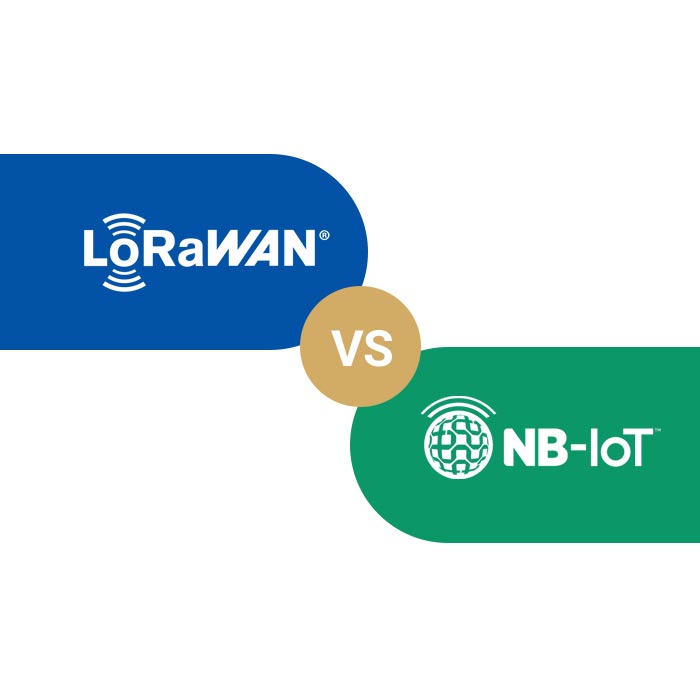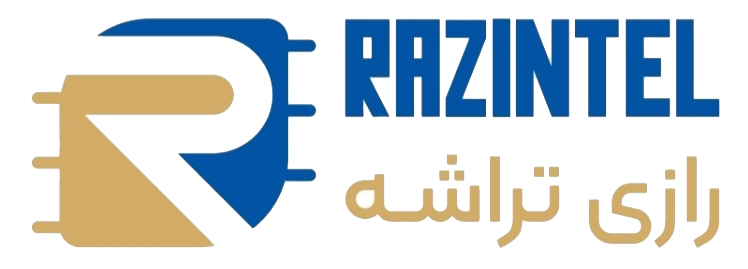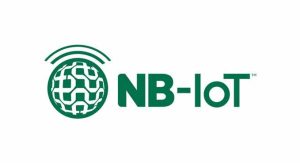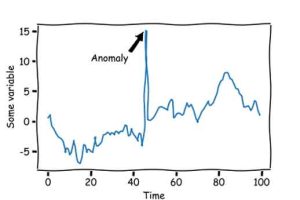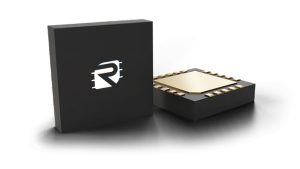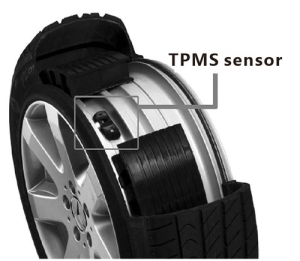LoRa vs. NB-IoT Network
The IoT revolution is in full swing, and LoRaWAN and NB-IoT are two dominant low-power wide-area network (LPWAN) technologies leading the charge. These long-range, low-bandwidth wireless solutions might seem complex, but they are the foundation of next-generation IoT applications.
From asset tracking in warehouses to smart farming and city-wide IoT networks, LoRaWAN and NB-IoT offer unparalleled connectivity. While short-range options like Zigbee and Bluetooth exist, they simply can’t compete with the extended range and multi-year battery life of LPWAN technologies. Whether you choose LoRaWAN’s open architecture or NB-IoT’s cellular integration, both deliver exceptional performance, transforming the way IoT devices communicate and operate.
Network Topology in LoRaWAN and NB-IoT
Both LoRaWAN and NB-IoT are leading low-power wide-area network (LPWAN) technologies, but they operate on different principles. LoRaWAN utilizes unlicensed spectrum and a proprietary spread spectrum modulation, while NB-IoT functions over licensed LTE bands with a narrowband 4G cellular approach. To understand their differences, it’s essential to explore their underlying technologies and network structures.
What is LoRaWAN?
LoRaWAN, as introduced in other post, developed by the LoRa Alliance, is a low-power, wide-area networking protocol designed for battery-operated IoT devices. It is based on the LoRa physical layer, which uses a proprietary Chirp Spread Spectrum (CSS) modulation patented by Semtech.
LoRaWAN offers bi-directional communication with features such as end-to-end encryption, data authentication, and mobility support. Devices communicate with the internet via LoRaWAN gateways, which aggregate data from multiple endpoints. While LoRaWAN’s open architecture reduces operational costs, each device requires a LoRa chipset for connectivity.
This technology is optimized for long-range, low-power applications, making it ideal for regional, national, or global IoT networks requiring secure and scalable communications.


What is NB-IoT?
NB-IoT (Narrowband IoT), as introduced earlier post, developed by 3GPP, is a cellular LPWAN standard designed to provide wide coverage and deep indoor penetration, making it ideal for stationary IoT devices like sensors and smart meters.
Unlike LoRaWAN’s unlicensed spectrum, NB-IoT operates in licensed bands owned by mobile network operators (MNOs). This provides a more reliable and interoperable connectivity solution, though at higher long-term costs compared to unlicensed LPWANs.
Standardized in 3GPP Release 13, NB-IoT can be deployed in in-band, guard-band, or standalone modes, allowing direct device-to-cellular base station communication without requiring gateways.
A rising trend in NB-IoT adoption is the use of Embedded SIMs (eSIMs), with 83% of organizations recognizing its importance for IoT (GSMA Intelligence). eSIMs enable global, flexible connectivity by provisioning IoT devices remotely, streamlining deployments worldwide.
Pros and Cons of LoRaWAN (LoRa™) and NB-IoT
Advantages of LoRaWAN:
- Long-range communication (up to 15 km in rural areas)
- Ultra-low power consumption (battery life of 10+ years)
- Supports private network deployment for independent operation
- Lower costs due to unlicensed spectrum usage
- Open standard with broad interoperability
Disadvantages of LoRaWAN:
- Low data rates, making it unsuitable for high-bandwidth applications
- Limited quality of service (QoS) and priority management
- Potential interference in dense deployments
- Requires dedicated gateways for connectivity
Advantages of NB-IoT:
- Higher data rates compared to LoRaWAN
- Leverages existing cellular networks for wide coverage
- Enhanced quality of service (QoS) and priority management
- Cellular-grade security and reliability
Disadvantages of NB-IoT:
- Higher deployment and operational costs
- Dependence on mobile network operators (MNOs)
- Shorter range and limited indoor penetration compared to LoRaWAN
- Higher power consumption, leading to shorter battery life
LoRaWAN vs NB-IoT: feature-by-feature comparison
LoRaWAN and NB-IoT are both leading LPWAN technologies, offering extended battery life, wide coverage, and cost efficiency, yet they differ significantly in key areas.
Range and coverage: LoRaWAN provides long-range connectivity (5–15 km per gateway) using non-GPS geolocation, ideal for rural and mobile asset tracking, whereas NB-IoT operates within a cellular architecture (2–3 km per cell), offering better indoor and urban coverage with GPS support.
Bandwidth and data rate: NB-IoT outperforms LoRaWAN with up to 200 kbps on LTE compared to LoRaWAN’s 50 kbps limit, benefiting from its licensed spectrum and robust MAC layer.
Latency: LoRaWAN prioritizes battery life at the cost of higher latency, while NB-IoT ensures lower latency by frequently checking in with the network, making it better for time-sensitive applications.
Network topology: LoRaWAN employs a star-of-stars model where gateways relay data to a central server, while NB-IoT follows a direct device-to-base-station architecture, leveraging existing cellular infrastructure.
Cost and QoS: LoRaWAN, using unlicensed spectrum, has lower deployment costs but offers limited QoS, whereas NB-IoT operates in licensed bands with higher costs but superior security and reliability.
Deployment status: As of 2024, LoRaWAN leads with 170+ operators in 181 countries, while NB-IoT has 124 operators across 64 countries, primarily in Asia and Europe, with both technologies expected to see significant growth in chipset shipments by 2027.
A comprehensive feature comparison of both networks is provided in the table below for better understanding:
| LORaWAN | NB-IoT | |
|---|---|---|
| Release Date | Older (2015) | Newer (2017) |
| Licensed spectrum | No | Yes |
| Ecosystem | LoRa Alliance | 3GPP |
| Coverage and range | 5-15 km | 1-10 km |
| Data rate | Lower | Higher |
| Latency | High | Low |
| Power Consumption | Very Low | Low |
| Support device mobility | Yes | Limited |
| Allow private networks | Yes | No |
| Roaming | Restricted | Yes |
| Cost | Lower for localized deployments | Higher, leveraging existing cellular networks |
Summurizing above table, the comparison highlights key differences between LoRaWAN and NB-IoT technologies across various parameters such as bandwidth, battery life, coverage, cost efficiency, throughput, geolocation, security, and latency. LoRaWAN is known for its long-range coverage, low power consumption, and support for private networks, making it suitable for applications requiring extended battery life and wide-area connectivity. On the other hand, NB-IoT, operating on licensed spectrum, offers higher data rates, lower latency, and better support for device mobility, leveraging existing cellular infrastructure. This comparison is crucial for selecting the appropriate technology based on specific application requirements, such as industrial IoT, smart cities, or asset tracking.
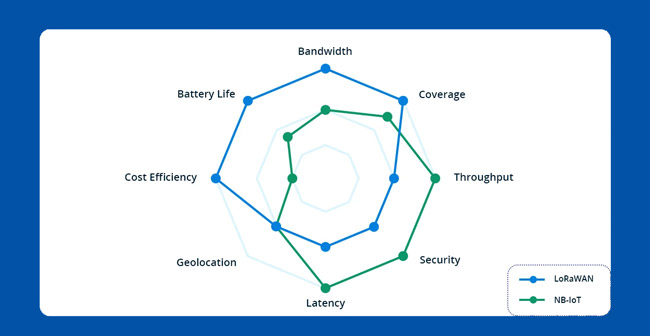
LoRaWAN vs NB-IoT: Which is Better for IoT Connectivity?
Labeling LoRaWAN vs NB-IoT as simply complements or competitors would be an oversimplification. While their use cases may overlap in certain areas, each technology excels in different scenarios, depending on their respective strengths.
LoRaWAN is ideal for rural or remote areas where cellular coverage is sparse. With its long-range capabilities, unlicensed spectrum, low power consumption, and cost-effective private deployments, it is well-suited for a wide range of applications. While often associated with remote areas, LoRaWAN also supports urban environments, handling smart utilities, buildings, industrial IoT, and more. Its non-GPS-based geolocation makes it particularly useful for battery-efficient mobile applications like supply chain and transport tracking.
In contrast, NB-IoT offers reliable, higher-bandwidth connectivity that’s perfect for real-time, mission-critical IoT applications. By leveraging existing 4G/LTE infrastructure, it is well-suited for smart cities, connected vehicles, and industrial use cases, particularly in urban environments. However, its higher deployment costs and reliance on power-hungry GPS can be limitations in rural areas with no cellular coverage.
Ultimately, the choice between LoRaWAN and NB-IoT depends on factors such as coverage, bandwidth, power requirements, mobility, and cost. Rather than selecting one over the other, strategically deploying both based on their respective strengths can create a robust IoT ecosystem across various use cases.
